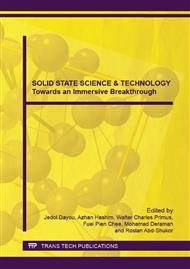p.341
p.347
p.353
p.359
p.365
p.371
p.377
p.383
p.391
Surface Modification of Graphitic Mesoporous Carbon Adsorbent by Chemical Oxidation for Removal of Basic Dye from Aqueous Solution
Abstract:
A graphitic mesoporous carbon-based material (GMC) was prepared using a nano-casting process by using SBA-15 as a hard template and sucrose as a carbon precursor. Modification of GMC was carried out by chemical oxidation with nitric acid in order to generate surface functionalities. The oxidized GMC material was then used as adsorbent for Basic Red 2 (BR2) in aqueous solutions. The morphology, pore structure, and surface functional groups of GMC samples were evaluated by field emission scanning electron microscopy (FESEM), Brunauer-Emmett-Teller method (BET), X-ray diffraction (XRD), Fourier transform infrared spectroscopy (FT-IR) and Boehm titration. N2 adsorption-desorption analysis revealed a type IV isotherm characteristic of mesoporous materials with BET surface area approximately 1000 m2g-1 and pore volume 0.9 cm3g-1. The effects of different adsorption parameters such as initial pH, initial dye aqueous solution concentration and temperature on BR2 removal were investigated. After modification, the BET surface area slightly decreased but the adsorption capacity of BR2 increased with optimum adsorption in 200 ppm initial concentration, pH of 10 at 60 °C.
Info:
Periodical:
Pages:
365-370
Citation:
Online since:
June 2015
Authors:
Keywords:
Price:
Сopyright:
© 2015 Trans Tech Publications Ltd. All Rights Reserved
Share:
Citation:


